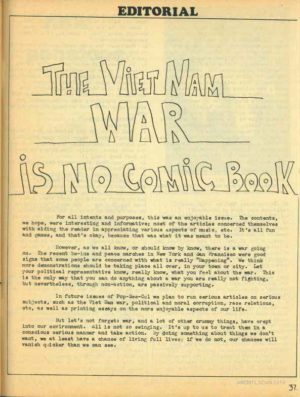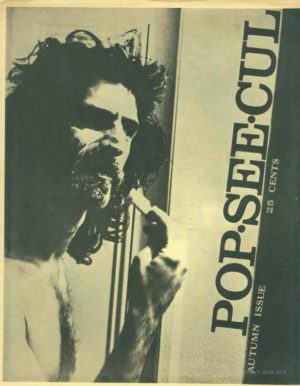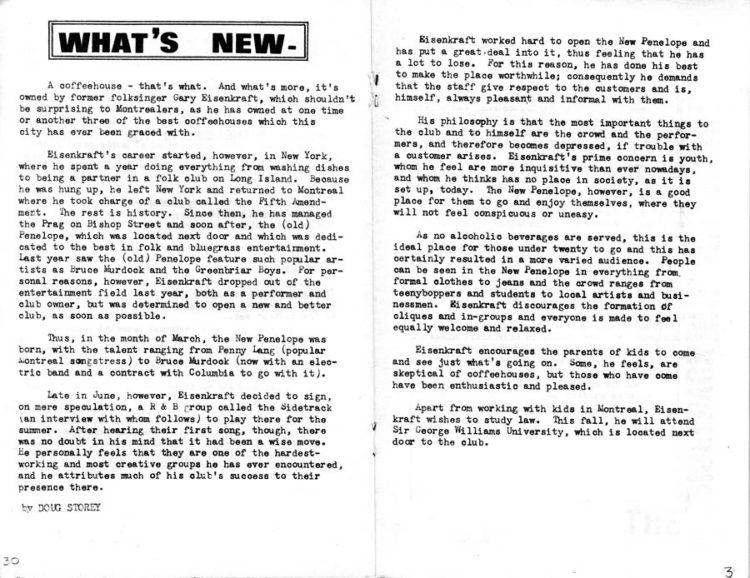Juan Rodriguez Rock Journalist Legend and Pop See Cul zine
LR: I guess that was the real left, the hard left…
JR: Yup. Although once in a while they had good stuff. Ray Affleck, he was good. He was a leader I admired. You see, at the time there was the Quiet Revolution, you could actually see it– everything sort of bloomed, it was quite amazing. The skirts got shorter, the church began to have no influence at all. I do remember the fifties, and you could feel “La Grande Noirceur” (The great darkness), a sort of dark atmosphere of God and quasi-Nationalistic politics from Maurice Duplessis. Once he’d died and Jean Lesage came in, it changed overnight. The whole atmosphere. One of the flower children of that era would be Geneviève Bujold, she was in that movie with Yves Montand (The War is Over) and she was kind of a symbol of the generation. They used her singing in the soundtrack in The Devil’s Toy, about skateboarding. I had a friend who was in the movie, he gave me the background about all the things that were happening. It absolutely defined youth, that film. It’s so freewheeling, they’re skateboarding down Mount Royal, I mean it’s gorgeous, you know? And she’s singing and time is undetermined at that point. Ultimately it was about defying a city bylaw that prohibits skateboarding. So, all the fun that you have for youth only exists for a short period of time before the city outlaws it. When I was growing up, it was the pinball machines that were “a menace”. There was this one place on Monkland I went to, an ice cream parlor with pinball machines in the back. It only lasted for a year or two, and it’s because all the parents got together and said, “We don’t want our kids hanging out at this seedy place.” And then the mayor said, pinball is only permitted on St-Catherine St., to not corrupt the youth. It’s the same today, when you’re fifteen, sixteen, you know, going to places that your parents wouldn’t have appreciated you going to. It was no big deal back then going to clubs downtown when I was fourteen, fifteen. They would let you in, as long as you don’t make any trouble, and you don’t get all drunk and then throw up everywhere…
LR: I presume you behaved so as to see the concerts!
JR: Yes of course, sip my soft drink! But by 1967, it was the year of acid everywhere in Montreal and people were just walking around zoned out of their minds. I actually didn’t start taking drugs until I got to the Montreal Star in 1969, and even then, it was about 1970 when I started smoking pot, and 1973 when I started taking coke. And coke was definitely a huge seventies drug. And of course, with the coke, I started drinking. But in ’67, people were dropping like flies because of the so-called LSD overdoses, it was a big, big acid town. I remember one guy who published a magazine– he may have had something to do with Logos– he went to Afghanistan to pick up hash. He made sandals that were totally made out of hash, and there was a little bit of Afghan embroidery around it, and he’d walk through customs wearing them! They didn’t have drug-sniffing dogs that back then… Anyway, in ’67 there was a free concert with the Jefferson Airplane and the Grateful Dead right in the middle of Place Ville Marie. On this splendid property, architecturally and sort of monument-wise, it really signalled Montreal as a modern city. And it’s still beautiful. Whenever I pass it, it’s a beautiful thing. And you had all these freaks there, with these two groups at that time were number one and two of the west coast sound.
AT: Did you see any of the big Sam Gesser shows?
JR: Yeah, I saw one that he really regretted bringing in; Janis Joplin. I got an interview with Janis, and it was in an empty dressing room, just me and Janis an hour before the show. In those days, you could do things like that. And somehow, she walks in with a full bottle of Southern Comfort. I had never tasted it before and it was delicious. It was this nice, syrupy thing and we got through about three-quarters of the bottle, there was about that much left…
LR: Less than an ounce…
JR: Yeah, and she was having a high old time, hugs, and all this kind of stuff…
LR: Would you just take notes in those days for interviews?
JR: Nope, I had a tape recorder. And after the show, she tumbled down the stage, a big embrace, and says, “Man, gimme a good review, man, I die up there, I live and die up there, gimme a good review.” How could I not? She was very powerful, and she was very much in the moment. But what had happened before, and I heard this from Ruth Gesser is that the moment that she left the interview, a fan came up and she threw up all over him. (Laughter)
LR: I assume that would’ve been a sold out show…
JR: Yeah, well there was about eight thousand people there. They had her band, Full Tilt Boogie, and Ken Pierson (from Montreal) played keyboards. I went over to Ken’s place, not that night, another night, and he opens up his fridge and the entire fridge is just beer, that’s it. And I thought (goofy voice), “That guy’s really cool, man.” And he was a very, very nice guy,
DD: He played on “Pearl.”
LR: Does he still live in Montreal?
DD: He’s on the South Shore. We were just talking to him the other night. He said, “Boy if we’d only known, with ‘Pearl’ and Janis,” they had no idea that she’d become so iconic, or that the band would break like that. And look how fast it ended.
JR: Yeah, when she died, in one respect it was a shock, but in another respect it was, like, no surprise, you know? But I found her at that time much more beautiful than she was in pictures. She was really glowing, very scantily-clad underneath, long, long hair, the pimples didn’t really bother you…
DD: She was an authentic person…
JR: Yeah, she was. She wasn’t a looker, and when the Montreal Fine Arts Museum an exhibition on the sixties a few years ago, they invited her sister to come to lunch. Her sister was quite a bit younger, and she had the same build exactly. Really sexy hips…
LR: You think she looked like what Janis would’ve looked like without the drinking and the drugs? (Laughs)
JR: Yup. And I got the same feeling from Mike Hendrix also, because I saw Hendrix at the Paul Sauvé Arena.
AT: That’s with Soft Machine and…
DD: Our Generation opened for them I think?
AT: Olivus, Bruce Cockburn’s heavy band, he wanted to cash in on this sort of hard rock thing, that lasted about three or four months, and then pfft. Then he started his real career.
JR: Oh boy, I gave him a rotten review. (Laughter)
LR: Did you interview Hendrix when he was here?
JR: No, no, but I just saw the show and it was totally amazing. I also wondered how long he was going to last. I met The Beach Boys in Hotel Bonaventure in ’68, and at the time I was doing the occasional story for Hit Parader Magazine. I did about three articles, and one of them was with Carl Wilson. He was very, very disturbed at that time because he had to go into the army, and he didn’t want to, and he was going to declare himself a conscientious objector and he didn’t know how the other guys would relate to that. Would it screw their image up as an all-American band? He was very, very nervous about it. That was funny. I spent the night with The Beach Boys and half of the band, Dennis Wilson, I think Carl also, and they had some black guys who were backing them up, we were at the Queen Elizabeth Hotel, in the ballroom, they were doing their rehearsals, and it was the first time I had ever tasted heroin. Because there was heroin going around The Beach Boys.
LR: Wow, “Surf’s Up”…
JR: Had the heroin, snorted it up, and the moment I got out of The Queen Elizabeth Hotel, right in the outdoor lobby; “BARF!”
DD: That’s the second barf story today (laughs). Did you ever write for Circus by the way?
JR: Uh, huh… I got in through Richard Meltzer, and also Lester Bangs. I wrote on the Montreal scene for Creem Magazine. I wrote for all of them at least once. Fusion Magazine, I did Rolling Stone, that was the article on Jesse Winchester, I did English Rolling Stone in ’69 where I reviewed Nick Cohen’s book that became a movie of some sort. All of those magazines, Crawdaddy…
LR: Do you remember what the cover story was for Creem?
JR: Well, it was a piece on the Montreal scene. I tried to make a bit more cultural about the influence of French and the English, bla, bla, bla. And also, Richard Meltzer had a sidebar, because Richard would come up to Montreal every year, and then I would go down to New York every year. Richard did an interview with Mahogany Rush, and Tony Roman was there of course. Tony did the first Mahogany Rush album. And that was when Frank Marino was making the whole story up about being reborn as Hendrix, great gimmick. Then years later, Frank is whining, bitching and moaning, “This asshole Juan Rodriguez spread this story about me and Jimi Hendrix, that asshole.”





Comments